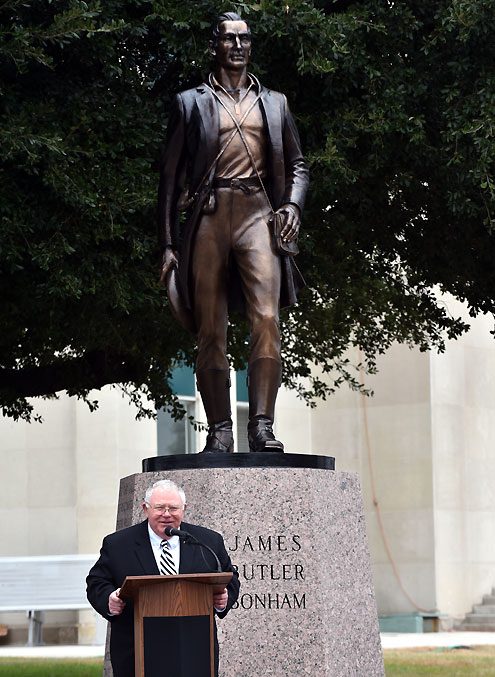Bonham -- "Remember the Alamo and remember Goliad," exclaimed Fannin County Judge J.E. Spies on December 18, 1938 as he accepted a statue of James Butler Bonham on behalf of the citizens of this fair city.
Those words rang out once again November 21 as a crowd gathered to honor Bonham's heroism in the face of almost certain death and to rededicate an historic statue of one of the heroes of the Alamo.
It seems like James Butler Bonham -- 178 years after the Saluda, South Carolina native gave his life defending the Alamo -- is having something of a banner year. After all, Texas A&M and the University of South Carolina now compete for the James Butler Bonham Trophy at their annual gridiron showdown. And in the town named after one of the heroes of the Alamo, a statue of Bonham sculpted by regional artist Allie Tennant has been restored to its original luster.
On March 26, 1936, Tennant received commissions to sculpt James Butler Bonham to be placed in the City of Bonham and Jose Antonio Navarro for the City of Corsicana. Tennant began work on both statues in her Live Oak Avenue studio in Dallas.
The clay model of James Butler Bonham was sent to one of the preeminent foundries in the nation, E. Gargoni & Sons in New York City, for the bronze casting.
In Early December 1938, the statue was sent to Bonham where a pink marble base, hewn from the same Marble Falls quarry that produced the state capital building in Austin, was waiting.
That was a special time in the history of Bonham and Fannin County. Bonham State Park had opened in 1936. Lake Fannin, one of the largest Rural Resettlement Administration projects in Texas, opened its gates to the public in 1938.
And Congressman Sam Rayburn, the man who played a prominent role in delivering both recreational facilities as well as the statue to his hometown of Bonham, made a speech when the James Butler Bonham Statue was unveiled.
On Friday, November 21,Texas State Historian (2009-2012) Dr. Light Cummins was in Bonham to speak at the rededication ceremony for the statue, calling it "glorious work of Allie Tennant."

Dr. Cummins said he first laid eyes on the statue 40 years ago and it has never looked better. He commended Fannin County Historical Commission for raising funds to restore the statue.
"James Butler Bonham was a true Texas patriot," remarked Cummins. "When he heard about the trouble out here in Texas, he felt it was his duty to come help Sam Houston. I would say that Bonham was certainly among the most heroic of the defenders of the Alamo."
Cummins told how Col. William B. Travis, one of the commanders of the Alamo, penned a letter asking for reinforcements to bolster the old Spanish mission and turned to Bonham, a friend since childhood, to deliver the message.
Bonham slipped out of the Alamo on his horse under the cover of darkness in hopes of mustering support. Help never came. Bonham had only been in Texas for a matter of months, but he rode back to the Alamo to die for the cause.
"In a true mark of heroism, he slipped back in," said Cummins. "On March 6, 1836, James Butler Bonham perished. He was the only one who left and came back. That's why this town was named for him. Remember the Alamo and remember Goliad. But today we also remember James Butler Bonham and Allie Tennant."








